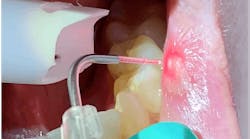How fee-for-service dentistry is making a comeback: An interview with Dave Monahan of Kleer
IN CASE YOU HADN'T HEARD, fee-for-service dentistry is back from the dead. New technology and market disruptors have leveled the playing field, giving dentists and dental practices the opportunity to set their own fee schedules—and keep more revenue for themselves. Plus, in some cases patients have access to transparent and more reasonable fee schedules.
Sound too good to be true? If so, you'll have to take up the issue with Dave Monahan. As president and CEO of Kleer, Monahan has a vision—and a business plan—for a company that can support dental practices ready to serve the next generation of fee-for-service patients. Kleer, which is set to beta launch in September and be available to dentists in January 2018, is a new cloud-based platform that allows dentists to offer in-house dental plans directly to patients. Kleer also allows dentists to design their own plans and fee schedules. Just as important, Kleer doesn't charge a single penny to dental practices in upfront fees. The bottom line is this: dentists using Kleer can keep around 90% of all fees paid by patients.
I spoke with Monahan recently about the dental industry trends that have opened up new opportunities for fee-for-schedule business models. Monahan and I also discussed the rise of in-house dental plans, how dentists can attract fee-for-service patients, and how Kleer is different from its competitors.
Fee-for-service dentistry is something every dentist wants to know more about, but you come at it from a different approach. Can you tell us a little more about your background and why you decided to start Kleer?
After selling my company in 2016, I spent some time reviewing the dental industry. I was curious why half of US consumers do not visit a dentist each year, especially given all the health benefits dental care provides. I conducted detailed market research that included interviews, focus groups, and surveys with dentists and consumers. I learned several things:
• Dental insurance does not work for dentists or patients. It’s too expensive, too complicated, and too limited. I know that this is not news to dentists, but it was news to me.
• Consumers understand the health benefits of dental care and want more treatment. The issue is that they have no idea how much treatment costs and assume dental care is too expensive.
• Consumers mistrust dental insurers and dentists. They assume the insurer does not care about them and that the dentist will push unneeded treatment.
• Dental patients with a dental care plan accept twice the amount of treatment as patients without a dental care plan. Interestingly, it does not matter if the dental care plan is insurance or a membership plan like Kleer.
• Dentists understand the value of their fee-for-service patients, but don’t do much to improve the satisfaction or compliance of these patients. The core issues are that dentists don’t have expertise in this area and have very little time outside their treatment schedules.
• Consumers have very high expectations of products and services they purchase due to apps like Uber and Airbnb. Dentists must keep these expectations in mind when offering services to their patients.
From this research, I determined that there was an obvious need for a service like Kleer.
Kleer dashboard
In your research for the development of Kleer, what was the top complaint you heard from dentists?
The biggest issue, hands down, is how difficult it is to deal with dental insurance. Managing insurance plans is time-consuming and expensive, and dentists feel beholden to them. Fees are too low, there’s a ton of paperwork, there are coverage limits that must be managed, and at the end of the day, claims are denied. I have talked to hundreds of dentists and, bar none, their descriptions of insurers are not flattering. Worst of all, for 70% of patients with insurance, the total copayments, coinsurance, and premiums they pay exceed the market value of the dental care they receive.
To provide an alternative to insurance, 10–20% of dentists have started their own membership plans. Although these plans have been successful, dentists and their staffs spend a lot of time and money creating and managing the plan. In addition, most plans are paper-based and lack important features that consumers expect and dentists need.
That’s why we started Kleer. We understand what consumers want and what dentists need, and are very good at user experience, software design, software development, and security. We did the legwork and built a great HIPAA-compliant solution that enables dentists to attract and retain more fee-for-service patients. Kleer enables dental practices to improve their top and bottom lines while focusing on what they love to do—treat patients.
As patients interact with more e-commerce sites and the new digital marketplace, their behaviors are changing. How would say patients’ preferences are changing the way that dental offices are run?
Thanks to the Internet, mobile devices, and apps, today’s consumers are more informed than ever and have higher expectations of the products and services they purchase. Consumers expect services to be offered online and demand that services be affordable, simple, transparent, and trustworthy. Our research shows that this applies to dental care the same way it applies to taxi rides or vacation rentals. Dentists need to adapt to this new reality and provide services centered on the expectations and needs of their patients, who are consumers at the end of the day.
In the past, dentists have sometimes been wary of offering membership plans. But that is clearly changing. What market forces are making membership plans more attractive to dentists, dental practices, and consumers?
First, consumers understand the health benefits of dental care and want more treatment, but they avoid treatment due to cost or fear of cost. The interesting thing is that they have no idea what the cost of treatment is. In our focus groups and interviews, consumers overestimated the cost of care by 200–500%. The great news is that when dentists offer their services directly to patients, they can provide care at a price point where many more consumers will buy.
Second, consumers want dental coverage, but are frustrated with complex dental plans that include hidden fees, fine print, and coverage limitations. They feel insurers have rigged the plans to work for themselves. And this distrust bleeds over to dentists. Our focus groups revealed patients felt dentists push unnecessary treatment and overcharge for procedures, but many of these patients linked this feeling back to the insurer since they know insurance plans drive dentist behavior. As a result, almost no one buys dental insurance if it is not subsidized by his or her employer, and 50% of US consumers go uninsured. There is a big opportunity to provide simple, affordable dental plans directly to these uninsured consumers.
Lastly, dentists understand that membership plans are a great way to engage their patients, but only 10–20% of dentists offer their own in-house plan. Most dentists admit they need help to create an in-house dental plan. They do not have expertise in software design and development, don’t have resources and/or capital to build a solution, and are too busy running the clinical side of their practices.
So, we have dentists that want to provide a service and consumers that want to purchase the service, but a very inefficient and complex marketplace that has keeps the two parties from coming together effectively. It’s time to change that. We created Kleer to enable dentists to easily provide simple, transparent, affordable dental plans to their patients and for patients to get the comprehensive dental care they want and can trust.
In your research, what did you find were the current frustrations that dentists and office managers face in growing fee-for-service patient bases, and how did you factor these into your business model?
Many dentists like to say that they went to dental school, not business school. They want to perform dental procedures, not worry about the details that go into tasks like growing and satisfying their fee-for-service patient base. So, they typically do nothing and are frustrated that their fee-for-service base is stagnant or shrinking. To get past this frustration, dentists need to change the status quo.
Pricing is a good example. Our research shows that 50 percent of uninsured consumers are interested in purchasing more dental care services, but assume they cannot afford it. Once we provided pricing based on a dentist offering services directly to the them, the consumers were very surprised and showed great interest in making a purchase. And the pricing was well above what dentist currently receive through insurance plans. However, most dentists do not want to provide pricing information. They feel this will open a can of worms that culminates in a race to the bottom on pricing. This is not the case. Dentists will not only get more patients and have existing patients accept more treatment, but they will receive higher fees relative to the insurance plans they currently accept.
How do membership plans differ, and what distinguishes Kleer from the pack?
I have reviewed many membership plans that are being offered by dentists and third parties. They all have a common goal, which is to enable dentists to bypass the middleman and offer a dental care plan directly to their patients. However, the plans fall short and don’t include important elements that are needed by dentists and patients. We addressed these elements in Kleer:
• Quick set-up—Kleer is very easy to implement. Dentists can set up a plan in 15 minutes by selecting the options that make sense for their practice, setting the subscription amount they will charge, and a creating fee schedule.
• Dentist benefits—Kleer enables dentists to maximize revenue and profit. There are no set up costs, monthly administrative fees, or hidden costs. We take a small monthly fee from each patient subscription. All other patient payments are made directly to the dentist, and the dentist keeps 100% of those payments. On average, dentists keep 90% of all payments made by a patient.
• Dental practice growth—Kleer has many features to attract new patients and retain existing patients. This includes items like a widget that can be embedded on a dentist’s website, an auto-renewal feature, marketing materials, marketing campaigns, and a unique digital referral program.
• Consumer friendliness—Kleer includes all the features consumers expect. This includes a selection of plans that meet their needs; a simple, fast, online purchasing process; a mobile app for managing the plan; and price transparency.
• Data privacy—Kleer is also HIPAA-compliant and secure. We have invested in software, hardware and processes to ensure patient data confidentiality and security. We will not use patient data in any way that has not been approved by the patient or does not meet HIPAA requirements.
Let's talk industry trends. What are the major practice management challenges you are seeing from dentists, whether they are new, in their prime, or in the practice-transition stage of their careers, especially in regard to fee-for-service patients?
The most common challenge dentists share with me across all these groups is decreasing their reliance on insurers and attracting new fee-for-service patients. Dentists have a lot of trouble running their practices profitably based on the fees provided under insurance plans and the overhead needed to manage them. They want to expand their practices, but don’t want to take in more insurance plans and/or insurance customers. They know that half of consumers in their community do not visit a dentist annually, but they don’t know how to attract them to their office. And as I mentioned, these consumers are very interested in purchasing a dental care plan if it is affordable, simple, transparent and trustworthy. So, there is a chasm between dentists that want to sell services and consumers that want to purchase services.
Membership plans sound good, but there are many kinds of patients out there. Does Kleer address this challenge?
Kleer enables you to offer three customizable and affordable dental care plans to your patients. The base plans are "Start," for price-sensitive patients or consumers that have been away from the dentist for a while; "Complete," for those who want comprehensive coverage; and "Perio," for those with periodontal disease. You pick the options that make sense for your practice, and then set the subscription price and fee schedule. Setup is very simple and takes about 15 minutes.
The Kleer care plans include typical preventative and diagnostic care (cleanings, exams, x-rays) and discounts on all other procedures (fillings, crowns, etc.). Kleer deducts a small administration and payment processing fee from the patient’s subscription payment and passes the remainder to you. All other procedures are paid for by the patient directly to your practice at the time of service and you keep 100% of those fees.
Patients can purchase the dental care plan from the dentist’s website, Kleer website, or Kleer mobile app using a credit card. They can also pay cash or use a credit card at their dentist’s front desk if they prefer.
Zachary Kulsrudis senior editor of PennWell's dental group. He serves as chief editor of Apex360 and managing editor of Dental Economics, and oversees the editorial team of DentistryIQ and Perio-Implant Advisory. His background includes work in advertising and broadcast production.
MORE FROM THIS AUTHOR:
15,000 patients a day: Exclusive interview with Bob Fontana, CEO of Aspen Dental Management Inc.
Dental school disruption 101: The story of CRET
The making of master craftsmen: Inside the groundbreaking Hu-Friedy apprenticeship program
Editor's note: This article first appeared in the Apex360 e-newsletter. Apex360 is a DentistryIQ partner publication for dental practitioners and members of the dental industry. Its goal is to provide timely dental information and present it in meaningful context, empowering those in the dental space to make better business decisions. Subscribe to the Apex360 e-newsletter here.












